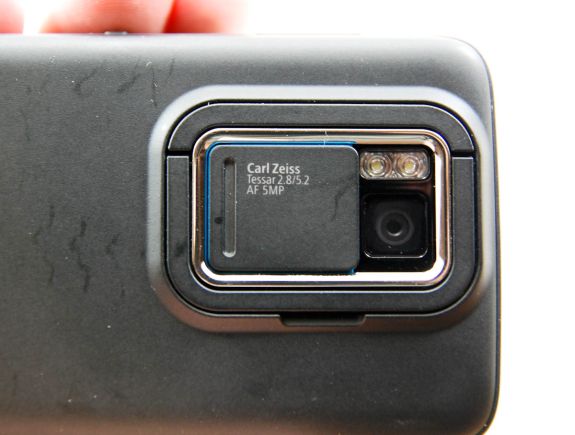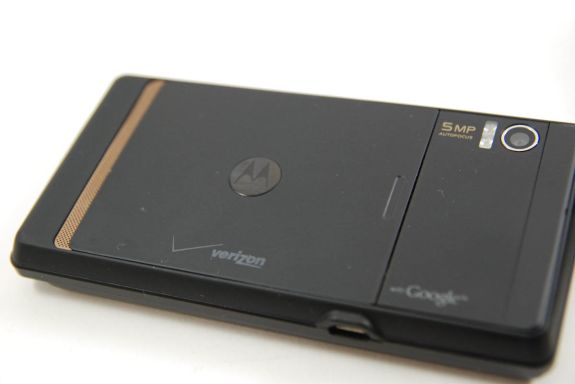Two OMAP 3430 Phones: Nokia N900 and Motorola Droid
by Brian Klug on June 10, 2010 9:29 PM EST- Posted in
- Smartphones
- N900
- Maemo
- Motorola Droid
- Droid
- MeeGo
- Android
- Mobile
N900 Camera
I've already talked briefly about the N900's camera, which is true to form for Nokia devices and pretty impressive. The software implementation that Nokia has put together for the N900 on Maemo is well polished. As mentioned before, sliding the camera cover open while the device is on immediately launches the camera application, or you can get there from the applications window. After launching, there are black bars at each side, the right side of which is used for settings icons. Nokia has included a ton of options here, including optional geotagging, settings for exposure, ISO, and preset shooting modes. You can capture in 3.5 megapixel or 5 megapixel modes, and have ISO 100, 200, 400 or automatic to choose from. In auto mode, it seems like the camera can go all the way to ISO 800 if necessary, but you can't set that manually. True to the rest of Maemo, the camera only works in landscape orientation.
What's really impressive is just how sharp and fluid the N900 camera preview looks while you're shooting. Suffice it to say, only the HTC Incredible really rivals how sharp and detailed the images look in the live preview. Framerate is always solid, and I just left the settings on defaults because I was pleased with the quality. The hardware button itself is two-position. Pushing halfway down triggers autofocus, pressing all the way takes the shot. One of the nice things is that if you jam the shutter button all the way down, it really takes the picture immediately; there's no mandatory AF run before actually capturing. This is potentially really handy if you're trying to capture something quick action and you're already confident it's in focus.
The N900 can capture videos at up to 848x480 at 25 fps in MPEG-4 format with AAC audio. That's an aspect ratio of 16:9 interestingly enough. I was a bit concerned initially about video being shot at 25 fps, but this is becoming more and more the case with 720P class smartphone video. Quality itself is very good as we'll see in a second.
Motorola Droid Camera
The Motorola Droid packs a slightly more standard 5 megapixel camera, also with autofocus and dual LED flash. While it doesn't carry fancy Carl Zeiss branding or advertise what kind of optical lens system drives it, it's likely the same or a very similar OmniVision camera sensor at the core. The Motorola Droid also supports video recording, though at slightly lower 720x480 resolution at slightly higher 30 fps. Video is encoded in H.264 and audio is AAC.
The camera application for the Motorola Droid is also stock Android 2.x. Love it or hate it, the application is essentially uniform across the platform with the exception of HTC's custom camera application like on the HTC Incredible. You've got settings for most of the basic things, but just not as much as you do on the N900 - though both of these have many more settings than iPhone OS which always handles everything with no chance for user override.
The camera can be launched either from the applications menu, or by pressing the dedicated camera button all the way down while the device is on. Motorola talked a fair amount about the copper colored camera button which - I guess - is a feature. Unfortunately, I did encounter a considerable amount of bugginess with the Droid's camera. Launch would periodically take a very long time (well over 8 seconds), in which case you'll probably just give up and move along, and I noticed a very strange quirk where switching from landscape to portrait (eg shutting the keyboard drawer) would result in camera UI elements being drawn in the wrong place. A few times, the frame around the camera preview would just render inside atop the image, which is very frustrating. Killing and relaunching fixes that, though.












68 Comments
View All Comments
Affectionate-Bed-980 - Friday, June 11, 2010 - link
You talk about the display brightness and how nice it looks, but you need to mention gamut. In some tests the 3GS shows ~65% of gamut, while the Droid shows 102%. Nexus One is at 141%. I expect the Incredible to be around there, so while the colors look nice on AMOLED, you must remember it's over-saturated and inaccurate while the Droid is spot on at 102%.fabarati - Friday, June 11, 2010 - link
I think you've misunderstood what gamut means.When a screen is advertises as 98% of the Adobe sRGB Gamut, it means that the screen covers 98% of the colours defined by Adobe for that gamut..
If it says 141% of the Adobe sRGB gamut, it means that it covers more than that defined area. It doesn't mean that the colours are oversaturated. It also doesn't mean that it can display all the colours there is.
Read up on gamuts on wikipedia:
http://en.wikipedia.org/wiki/Gamut
Powerlurker - Friday, June 11, 2010 - link
On the other hand, I doubt that anyone is going to do color correction or some sort of display calibration on their smartphone, and since most companies set their displays to be somewhat saturated by default, I would guess that in practice the Incredible's AMOLED screen will be oversaturated compared to the Droid's LCD.Brian Klug - Friday, June 11, 2010 - link
So here's the problem - there's absolutely no way to measure it. Or at least, I haven't found an acceptable solution.Going off the display panel numbers seems extremely unrealistic for obvious reasons, but barring that there are other bigger problems.
1. Android uses 16-bit color in a lot of places because they're rendering them with 3D OpenGL compositing and compressed textures. One of the most glaring - and dare I say troubling - examples is right inside the gallery application. The gallery application in 2.0.1 was full 24-bit color, but in 2.1 Google contracted with Cooliris to develop a more flashy 3D gallery. Obviously, the limitations imposed by the GPU on different devices (and possibly even from the POV of what textures are supported) necessitated 16-bits per color. In practice, it just looks awful. Without even being nitpicky, I can notice lots of banding.
2. The AMOLED displays use the PenTile array, which also does a lot of dithering inherently - in fact, their pattern is essentially trying to get around Nyquist by being very creative with the human eye system, and this intermediate software layer of theirs. The consequence is that it ends up smoothing and dithering the 16-bits, making it really hard to see the banding, but it's still there. Pull up the color gradient images from the article and scrutinize the Incredible. There's no banding, but in person, you can stlll pick out dithering and a problem.
3. I still have no way of doing gamut testing on any mobile devices. So back when I started on the iPad article, I had a (relatively clever, I think) idea to use the calibration software through a 24-bit remote desktop session, tricking it into using any mobile device like a screen. This just doesn't work for reasons outside my understanding. I've done it on iPhone OS and Android, and for some reason the results are just complete bogus. So there's no way of really telling what the % gamut coverage of Adobe 1998 any of these things are. Moreover, since there's no way of loading a display profile on them, you're really stuck with whatever it shipped with anyways.
The sad state of things is that AMOLED "looks" brighter and more contrasty, but the color accuracy is just undoubtedly wrong. I mean, it's obvious to make that comparison when you're surrounded by calibrated IPS panels with Delta-E tracking under 1.0, you hold up any of the phones, and see a veritable library of differently hued photos.
I'm open to any suggestions you guys have for really measuring gamut. I mean, we could try being more manual and laboriously testing colors one by one (that's basically how I do brightness - white, black, and contrast) but, is it worth it?
KevinToon - Friday, June 11, 2010 - link
Shouldn't the speakerphone testing be done with the devices suspended off the desk??I know my phone sounds different if it's on a hard surface like a desk.
R3MF - Friday, June 11, 2010 - link
I have an n900, so thanks, good article.Found an interesting MeeGo article since you mentioned it:
http://jedibeeftrix.wordpress.com/2010/06/06/ultim...
medi01 - Friday, June 11, 2010 - link
May I ask why 3GS is missing from "side by side comparison"? Just an incident or you are THAT afraid of Mr Jobbs marketing's wrath?dtreader - Friday, June 11, 2010 - link
Wow! Just moments after finally placing my order for an N900 about eight hours ago (I've been lusting over this phone ever since it was just rumored to exist), I noticed this article on AT, with no comments having been posted to it yet. Cool, huh?I have a feeling there are many people like me....people that have been thinking about purchasing this incredible phone, but have been holding back for various reasons: for the price to come down a bit, to see how Nokia supported it with software updates, to find out about bugs and if they're being fixed, to feel comfortable about the future of Maemo on the N900 and, at this point, feeling comfortable about buying this phone even if Nokia comes out with something better in a few months time.
I've been depending daily on my flip phone/N800 tablet combination for a few years now, and have been dying to step up to the next level, even before I knew that would come in the form of the N900. A few months ago I looked at the Droid (currently I'm with Verizon), and lately considered the htc EVO on Sprint, but when you combine the current capabilities and the exciting future of the N900 (thanks to its truly open philosophy and dedicated enthusiast/developer base), I just couldn't wait any longer to get on board! T-Mobile 3.5G here I come!
Thanks for this article, Anandtech! You've been my main "source for hardware analysis and news" for over ten years now! :)
Go N900!!!
milli - Friday, June 11, 2010 - link
"From a performance perspective, the Motorola Droid's 550 MHz Cortex A8 simply isn't a match for the 1 GHz A8 in Snapdragon's Scorpion CPU ... "That should read: ... for the 1 GHz Scorpion CPU in the Snapdragon ...
There's no Cortex A8 in the Snapdragon.
Brian Klug - Friday, June 11, 2010 - link
That's being a bit semantic I think.Inside the Snapdragon is a Scorpion, which is Qualcomm's trade name for their hardened (1 GHz supporting) Cortex A8 CPU.
Cortex is the ARM Family, ARMv7-A is the family, and Cortex A8 is the fully qualified core name.
So really, either one is correct ;)
-Brian